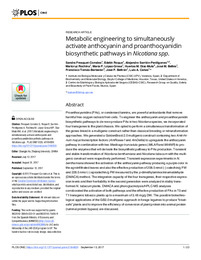Por favor, use este identificador para citar o enlazar este ítem:
https://hdl.handle.net/11000/31416
Metabolic engineering to simultaneously activate anthocyanin and proanthocyanidin biosynthetic pathways in Nicotiana spp
Título :
Metabolic engineering to simultaneously activate anthocyanin and proanthocyanidin biosynthetic pathways in Nicotiana spp |
Autor :
Fresquet-Corrales, Sandra
Roque, Edelín
SarrioÂn-Perdigones, Alejandro
Rochina, Maricruz
López-Gresa, María P.
Diaz-Mula, Huertas Maria 
Bellés, José M.
Tomás-Barberán, Francisco
Beltrán, José P.
Cañas, Luis A. |
Editor :
Public Library of Science |
Departamento:
Departamentos de la UMH::Biología Aplicada |
Fecha de publicación:
2017-09-13 |
URI :
https://hdl.handle.net/11000/31416 |
Resumen :
Proanthocyanidins (PAs), or condensed tannins, are powerful antioxidants that remove
harmful free oxygen radicals from cells. To engineer the anthocyanin and proanthocyanidin
biosynthetic pathways to de novo produce PAs in two Nicotiana species, we incorporated
four transgenes to the plant chassis. We opted to perform a simultaneous transformation of
the genes linked in a multigenic construct rather than classical breeding or retransformation
approaches. We generated a GoldenBraid 2.0 multigenic construct containing two Antirrhinum
majus transcription factors (AmRosea1 and AmDelila) to upregulate the anthocyanin
pathway in combination with two Medicago truncatula genes (MtLAR and MtANR) to produce
the enzymes that will derivate the biosynthetic pathway to PAs production. Transient
and stable transformation of Nicotiana benthamiana and Nicotiana tabacum with the multigenic
construct were respectively performed. Transient expression experiments in N.
benthamiana showed the activation of the anthocyanin pathway producing a purple color in
the agroinfiltrated leaves and also the effective production of 208.5 nmol (-) catechin/g FW
and 228.5 nmol (-) epicatechin/g FW measured by the p-dimethylaminocinnamaldehyde
(DMACA) method. The integration capacity of the four transgenes, their respective expression
levels and their heritability in the second generation were analyzed in stably transformed
N. tabacum plants. DMACA and phoroglucinolysis/HPLC-MS analyses
corroborated the activation of both pathways and the effective production of PAs in T0 and
T1 transgenic tobacco plants up to a maximum of 3.48 mg/g DW. The possible biotechnological
applications of the GB2.0 multigenic approach in forage legumes to produce ªbloatsafe
º plants and to improve the efficiency of conversion of plant protein into animal protein
(ruminal protein bypass) are discussed.
|
Área de conocimiento :
CDU: Ciencias puras y naturales: Biología |
Tipo de documento :
info:eu-repo/semantics/article |
Derechos de acceso:
info:eu-repo/semantics/openAccess
Attribution-NonCommercial-NoDerivatives 4.0 Internacional |
DOI :
https://doi.org/10.1371/journal.pone.0184839 |
Publicado en:
PLoS ONE 12(9), 2017 |
Aparece en las colecciones:
Artículos Biología Aplicada
|
 La licencia se describe como: Atribución-NonComercial-NoDerivada 4.0 Internacional.
La licencia se describe como: Atribución-NonComercial-NoDerivada 4.0 Internacional.
 La licencia se describe como: Atribución-NonComercial-NoDerivada 4.0 Internacional.
La licencia se describe como: Atribución-NonComercial-NoDerivada 4.0 Internacional.
.png)
